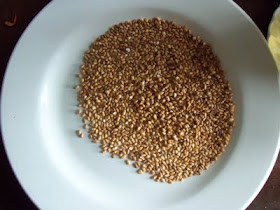 I've been threatening to make kimchi for years now. It's probably the pickled product I eat most frequently, above sauerkraut or even (cucumber) pickles. I eat it in soups, fried rice, stir-fries, tucked inside dumplings and right out of the jar. If you're not familiar with it, kimchi is the broader name for the ubiquitous class of Korean pickled vegetables that comes in many forms seasonally and regionally. The most instantly-recognizable version of it, paechu kimchi, is primarily composed of napa cabbage, usually with daikon radish and scallion, liberally dosed with ginger, garlic and ground chile and, often, ground, dried shrimp and anchovy sauce.
I've been threatening to make kimchi for years now. It's probably the pickled product I eat most frequently, above sauerkraut or even (cucumber) pickles. I eat it in soups, fried rice, stir-fries, tucked inside dumplings and right out of the jar. If you're not familiar with it, kimchi is the broader name for the ubiquitous class of Korean pickled vegetables that comes in many forms seasonally and regionally. The most instantly-recognizable version of it, paechu kimchi, is primarily composed of napa cabbage, usually with daikon radish and scallion, liberally dosed with ginger, garlic and ground chile and, often, ground, dried shrimp and anchovy sauce.Most versions of it contain at least one of the above ingredients. However, as most is true with many beloved culinary archetypes, such as pierogi and gumbo, the authenticity of which are fiercely defended, it's "authentically" made with whatever's available at the time. Spring tends to bring radish-based kimchi and summer kimchi often includes light greens and cucumber, while fall is dominated by cabbage. Additionally, chiles were not introduced to Korean cuisine until about the 17th century, while kimchi dates back to at least the 13th century, so much of the history of kimchi exists without chiles, as do some varieties of the dish.
Paechu kimchi is often made in large quantities during the November cabbage harvest, to store up for the winter. Historically, this kimchi is made during kimjang, events where a family or community will gather to process truly impressive quantities of cabbage and other ingredients. While an increasing number of Koreans buy most of their kimchi, the practice of kimjang is still alive and well in many families. Saveur magazine chronicled one family's kimjang process in a 2009 article, "The Art of Kimchi".
I'm not entirely sure what's taken me so long to try it out myself. In many ways, it's more simple than many pickling projects. Here's the process in 5 easy steps, including eating:
- Cut vegetables.
- Brine vegetables.
- Season vegetables.
- Ignore vegetables.
- Eat pickles.

The next obstacle was a fermentation vessel. The most traditional forms of kimchi are fermented in earthenware vessels buried in the ground to keep them at a cool, consistent temperature (à la root cellar). Metal, which can react and interfere with the fermentation process, is out. Most of my large glass containers are currently being used for grain storage or for Maria's kombucha babies. Plastic is workable, but I spent a while ogling various, purpose-designed earthenware fermentation crocks, which are gorgeous and well-designed, but rather expensive. Then, in my preliminary research, I came across a stunningly elegant suggestion from wild fermentation guru Sandor "Sandorkraut" Katz: a crockpot is a glazed earthenware vessel - with a lid, no less - and if you don't have one, you can probably find one at the thrift store for $5 or less.
Armed with cabbage, beets and my crockpot, I finally got started. I sliced up about 5 lb. of cabbage and three big beets and set them in a salt solution (¼ c. salt:1 qt water, shake vigorously until salt dissolves, repeat as necessary to cover veggies) overnight, half in the crockpot and half in a big plastic bowl. For weights, I found two different plates that fit neatly over the top of each vessel and pressed them down, weighting them with jars full of water. The next day, I drained off the brine (reserving the brine from one of the two bowls), and dumped all the veggies into the bowl to be mixed with the aromatics. They had reduced in volume somewhat after their night in the brine, and fit into one of the two containers. I didn't have any of the traditional Korean chile powder, but was determined not to go buy something specifically for this project, so I took the suggestion of the Tigress, whose basic recipe I was using for guidance, of using a blend of equal portions cayenne and sweet paprika. I also minced up a whole head of garlic about an equal volume of fresh ginger. I put on a pair of gloves and went to town massaging the spices and a little sugar into the veggies. I loaded the whole mess back into the crockpot, poured in just enough of the reserved brine to cover, weighted it with a small plate and a bowl of water, put the lid on and stuck it in a dark corner of the counter to be ignored.
Ignoring it and waiting: this is really the hardest part. Thankfully, it's not a project that also bears the "leave alone; do not touch" instruction; you can and should poke at it and sample it daily until it's fermented to your taste. It should start to bubble and develop a sour tang after about 2 days, and should reach fermented fullness after 3-6 days, depending on temperature and other conditions. Mine got so excited when the fermentation really kicked in on Night 2 that it burped up some of its liquid on the counter. Once it's sour enough for your taste, you can load it into jars and put it in the fridge, which will slow the fermentation drastically, so it won't get more sour.
Unlike many other preserving projects, like jams or the recent watermelon rind pickles, you don't want to process this one in a hot water bath; that would kill all the happy little probiotic beasties, namely, Lactobacilli bacteria.
 This is the same family of little guys that also help make yogurt, beer, wine, and sourdough (there is actually a specific Lactobacillus kimchii!), and are responsible for many of the numerous touted health benefits of kimchi. Kimchi has been reputed to help everything from colds to UTIs (both of which, interestingly, have research to back them up) to cancer and stress, and many ailments in between. As far as nasty bacteria that could make you sick, salting the vegetables prevents the growth of harmful bacteria. If you think about the process, it's similar to making yogurt, and no more likely to make you sick.
This is the same family of little guys that also help make yogurt, beer, wine, and sourdough (there is actually a specific Lactobacillus kimchii!), and are responsible for many of the numerous touted health benefits of kimchi. Kimchi has been reputed to help everything from colds to UTIs (both of which, interestingly, have research to back them up) to cancer and stress, and many ailments in between. As far as nasty bacteria that could make you sick, salting the vegetables prevents the growth of harmful bacteria. If you think about the process, it's similar to making yogurt, and no more likely to make you sick.We'll see what the next round will bring; now that I've gotten over the initial hump of worrying that I'll mess up and waste a bunch of ingredients, I'll try adding more flavors. I have my eyes on the little dried shrimp used in many traditional kimchi preparations. Both Sandorkraut and the Tigress stress the generous flexibility of lacto-fermentation, and its long history of being done almost entirely to taste. Archeological evidence suggests that laborers working on the Great Wall of China 2000 years ago were eating fermented cabbage and that it was introduced to Europe by Mongol hordes after the Great Wall wasn't quite great enough. Or, maybe I'll just come up with some other concoction that can only dubiously be called kimchi.

- 5 lbs cabbage, sliced into 1" strips
- 3 med-large beets, peeled and cut into ¼" sticks
- 2 Tblsp. Korean chili powder OR 1 Tblsp. each of cayenne pepper and sweet paprika
- 1 smallish head garlic, minced (about ¼ c.)
- ¼ c. fresh ginger, peeled and minced
- 1 Tblsp. sugar
New England Late Summer Kimchi
vegan, grain/gluten-free, rawmakes about 3 qts
The seasoning:
The next day (or 8-12 hours later), drain the veggies, reserving at least half of the brine for the fermentation. Dump drained vegetables into a large bowl with room to mix. Prep seasonings and add to bowl. Using gloved hands (don't make me tell you horror stories about chili hands!), massage the spices into the vegetables to get even distribution and good mojo going. Load your proto-pickle into fermentation vessel(s) (e.g. crockpot, glass jar), add reserved brine to cover, and cover with plate/weight as for salting.
Check daily. Fermentation should start to kick in on day 2 or 3, and probably won't take more than 6 days to reach full flavor. Speed of fermentation will depend on temperature and other conditions. When kimchi has reached desired level of doneness, pack into clean jars and refrigerate. Refrigeration will drastically slow fermentation, but it may get a little more sour over several months of storage.
- The Tigress' Kimchi Primer
- Sandorkraut, "Vegetable Fermentation Further Simplified" - His website also has a searchable fermentation Q&A and a fermentation support forum
- Mei Chin, "The Art of Kimchi." Saveur Magazine, Nov. 2009.
Recommended Reading






























